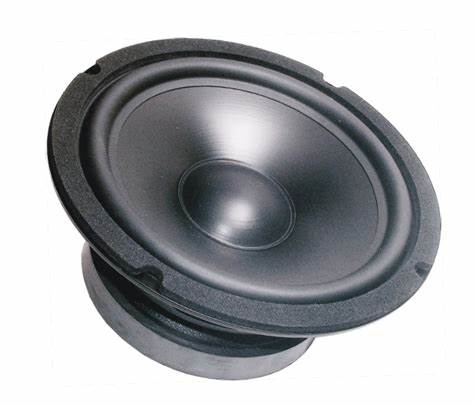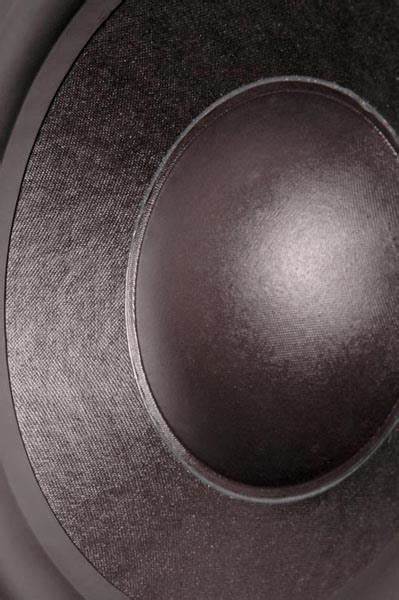When we listen to audio equipment, of course we pay the most attention to its sound quality. An author wrote that the sound quality of a speaker box is the most important, and it does not matter what material the speaker diaphragm is made of. There is nothing logically wrong with this sentence; the key lies in its substance. This sentence seems to be said in reverse, the speaker diaphragm material is very important, and the diaphragm material plays a vital role in the sound quality of the speaker.
Different diaphragm materials determine the sound quality orientation of the speaker, or in other words, in order to make the sound quality of the speaker satisfactory, you have to go to great lengths to choose a new material. The selection and application of a new material often means a change in the speaker cabinet. In the early years, electric speakers basically used pulp diaphragms, and the speakers at that time were called paper cone speakers. In the 1990s, the polypropylene diaphragm (PP basin) appeared; and then the bulletproof cloth diaphragm (Kevlar fiber) appeared, which gave people a refreshing feeling.

What is good sound quality?
In the audio industry and among audio and music lovers, the term sound quality is on the lips almost all day long. What is the sound quality? Like many everyday concepts, we rarely think about it or delve into it. As the name suggests, or literally, sound quality is the quality of the sound. But what is sound quality? How to express the quality of sound, how to measure it and how to evaluate it? Are there any objective, universally recognized standards?
The difference in understanding human voices is even more subtle. We can distinguish between strangers and acquaintances. For people we are familiar with, “even if we haven’t seen them, it’s as if we heard their voices.” You can accurately identify the arrival of an acquaintance just by the sound of footsteps, door opening, and coughing. The auditory impression corresponding to this distinction is called timbre. Each sound has its own characteristics, and the sound has an invisible and intangible mysterious color.
When evaluating and describing sounds, we often feel that we are lacking in words. So we turn to daily experience for help. Since there are colorful pictures, there can be colorful sounds. In addition to color, we describe sound music that constantly draws on familiar everyday experiences. The sense of warmth describes the coldness and heat of the sound; the sense of physics describes the softness, crispness, looseness, and hardness of the sound; the sense of physics describes the thickness, thinness, narrowness, and width of the sound. The timbre is related to the composition and time structure of the sound.
We might as well explore the issue of timbre a little more physically. There are all kinds of sounds in the world, and there are a wide variety of musical instruments in various countries and regions. Naturally, their timbres are different. Timbre is also related to the component structure of the sound. The sound components are simple and the purest are pure tones, and there are very few pure tones in nature. Pure tones of various frequencies can be emitted by instruments such as audio signal generators.
Recently, some magazines burned pure audio signals into CDs and gave them away, which is convenient for many readers who do not have instruments. You really need to feel what the pure sound of 400Hz and 600Hz tastes like, especially for people who have never experienced it. The feeling of pure sound is “light” and “clear”, “light” means light when the sky is high and the clouds are light; “qing” means when the water is extremely clear and there is no fish in it. If the sound is thin, it is not music. A sound composed of multiple components has a richer timbre.
All kinds of musical instruments (excluding electronic musical instruments first) do not emit pure sounds of a single frequency or single vibration. The sound of musical instruments is generally composed of the fundamental tone and the harmonics that are integer multiples of the fundamental tone. Almost all sounds in nature are composite sounds, including harmonics and noise with different amplitudes, thus forming different timbres.
The spectrum of the flute shows relatively few harmonics. The flute’s sound range is relatively narrow, approximately between 600 and 6000Hz. Mozart wrote two flute concertos, which showed the various timbres of the flute. Some people love to call the flute “coloratura soprano”, which shows their love for the flute.

The spectrum of the violin includes many high-order harmonics, which means the tone is full and round. The timbre of string instruments is extremely rich and complex. People highly admire the famous Italian violins of Stradivari and Guarantee 200 years ago, and even violins made with the same shape, size, materials and craftsmanship are difficult to compare with. Experience tells us that it is very difficult to find two identical people in the world, and it is also quite difficult to find two violins with the same timbre, let alone different players’ playing skills and control of the changes in timbre.
There will also be a certain amount of noise in musical instruments. Like percussion instruments, noise plays an important role in the timbre. The spectrum of a cymbal. Not only is there no integer relationship between the components, the timbre is messy and there is a lot of noise. Even if it is a violin, the bow is pulled on four strings, and the bow is smeared with rosin.
When the bow pulls the strings, it will not only make a song-like sound. It’s a touching piece of music that’s like a dream. There will also be friction noise. The higher the pull position, the greater the noise. Some audiophiles say they can hear the pine scent of the violin, but so far it has not been found that sound can spread the scent.
The association caused by this friction noise is probably the pine scent that some of us audiophiles recognize. In addition, timbre is also related to the time structure, that is, it is closely related to the way the sound is established and decayed. Piano spectrum diagram is shown.
The sound of the piano starts out strong when you press it, and then gradually decreases as you play it. The organ gradually increases the sound level, maintains a certain sound level for a short period of time, and then decays relatively quickly. This can also be called sound shape, envelope.
To summarize the above meaning, the reason why there are different sounds and colors, in terms of composition, is because the components of each sound are different. It will have many harmonics and noise; these harmonics and noise may or may not have certain rules. In terms of time structure, its shape is different, and its diaphragm’s relationship with time is also different.
The combination variations are endless. A good speaker should reproduce the timbre characteristics of the music without distortion.
The reproduction sound quality of the speaker mainly depends on the diaphragm material

As far as the commonly used and commonly seen electric speakers are concerned, their objective test indicators mainly depend on their structure and geometry. The sound quality depends on the speaker diaphragm material, the type of diaphragm material and its physical properties.
For example, B&W 801’s low-frequency unit diaphragm originally used an aluminum alloy diaphragm. Although the test results were good, the subjective sound quality evaluation was not so ideal, so a paper frame diaphragm mixed with 10% Kevlar fiber was finally used.
According to research, the sound quality of the speaker diaphragm depends on three indicators of the diaphragm material: they are the elasticity (elastic modulus E), density (p) and appropriate internal damping of the diaphragm material. That is to say, we hope that its elastic modulus E is high, its density p is small, and it also has appropriate internal damping. In this way, the speaker propagates quickly, rises quickly, and has appropriate internal damping to dampen unnecessary clutter.
The vibration stops and falls quickly, and the sound is clean and soft. But no gold is pure, and no man is perfect. There is no absolutely ideal diaphragm material in the world. For example, the steel alloy diaphragm has high elastic modulus, low density, responds quickly to vibration, and has strong explosive power of sound.
However, the internal damping of metal is small, so it is difficult to stop the vibration quickly, and the sound is not clean. On the contrary, for pulp materials, the sound is relatively soft, the sound rises slowly, but the fall speed is fast, and the intensity is not very strong.
It is very difficult to find materials with large E/p and sufficient internal damping at the same time. In recent years, with the development of materials technology, many new materials have emerged. “It doesn’t matter what material the diaphragm is made of, as long as the sound quality is good.” This sentence can be thought of as “what kind of diaphragm material is used generally determines the sound quality of the speaker.”
We often see people evaluating the transient response of speakers, mentioning that a certain speaker has good transient response or good transient response. After careful analysis, the problem arises. There are two situations in the transient state that we often talk about. One is rising, the sound comes from nothing, and the other is falling, the sound comes from nothing.
We hope that the sound can be completed instantly from nothing to something, and the sound from something to nothing can be completed instantly, but this is very difficult. If you need a material to rise faster, it will fall faster, which is almost impossible. For example, metal materials rise quickly and fall more slowly. It will produce a damped oscillation, which is not easy to disappear. The moon waxes and wanes, people have joys and sorrows, and it is not easy to have a speaker that is good at both ends.
Therefore, there are speakers with different sound qualities with different diaphragm materials. In other words, if there are 10,000 different types of diaphragms, there will be 10,000 speakers with different characteristics. Speakers are similar to paintings. We not only want to convey the form (no distortion), but also convey the meaning (good sound quality). We try to achieve both, but it is impossible in practice.
